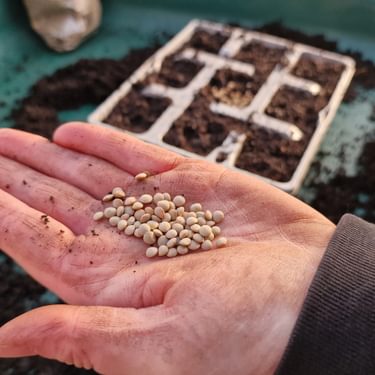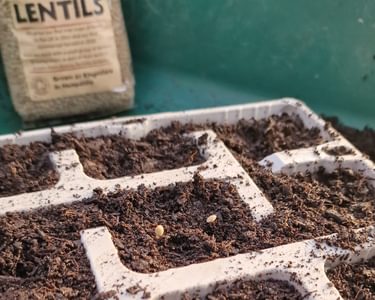
Lentils
| Growing calendar | |
|---|---|
| Sow indoors | April |
| Sow outdoors | May |
| Plant out | May/June |
| Harvest | 100 days after sowing |
Lentils are part of the legume family and produce low growth, approximately 40-50cm high, with tiny blue, pea-like flowers. These give rise to large numbers of pods, which house one to two lentils.
Lentils have nodules on their roots, which suggests they might make a good green manure, fixing nitrogen and adding organic matter to the soil.
Sowing and growing lentils
Sow indoors in April in modules of peat-free compost, with two to three lentils per module. Harden off once they show true leaves and planted outdoors, 30cm apart in rows.
Lentils will grow on a range of soil types but dislike wet soils so ensure the ground is free draining. They are reasonably cold tolerant but their ability to tolerate frost varies with variety and the stage of growth. They require a sunny, well-drained spot without other plants overshadowing them.
You can also sow directly outdoors when it’s warmed up in May. Go for about 10g lentils per one square metre, 30cm apart in rows. They should germinate in approximately 10 days.
Tips for growing lentils
While lentil seeds are often sold for growing as a sprouting micro-veg, it’s almost impossible to get lentils for outdoor growing from vegetable seed suppliers, especially if you need them to be organic. Hodmedods grow them organically on a commercial scale and recommend their olive-green lentil, which has not been treated in any way and so will still be viable.
If you’d like to try growing them yourself, remember shop-bought varieties might have been harvested from plants grown abroad and might not be suited to our growing conditions. They may also have been treated and therefore will not be viable seed. Only grow whole, dry lentils not the split ones.
Harvesting and storing lentils
Lentils can be very time consuming to harvest. You can remove the whole plant when yellow and allow them to dry out before placing in a sack and shaking vigorously to shatter the seedcases. Or wait for the pods to go brown and pick them by hand, either splitting the pods open there and then or allowing them to dry out further and doing it indoors to prevent spillages.
The lentils can be winnowed out after a quick sieving to get rid of twiggy bits.
Once dried they have a long storage life, up to two years.
Lentils are a good source of protein, containing about 25 per cent when uncooked, decreasing to about 10 per cent when cooked, due to the extra water absorbed.
We're growing lentils in our organic demonstration garden in 2024 - head to our blog to keep updated on progress. We also did a citizen science experiment into lentil growing in 2019. Click here to read the report.

| Growing notes | |
|---|---|
| Difficulty | Easy |
| Germination time | 10 days |
| Average time to harvest | 100 days |
| Equipment needed | None |
| Average plant size | 40-50cm |
| Family group to grow with | Fabaceae - legume |
| Key nutritional content | High in protein, folate, B vitamins and potassium |